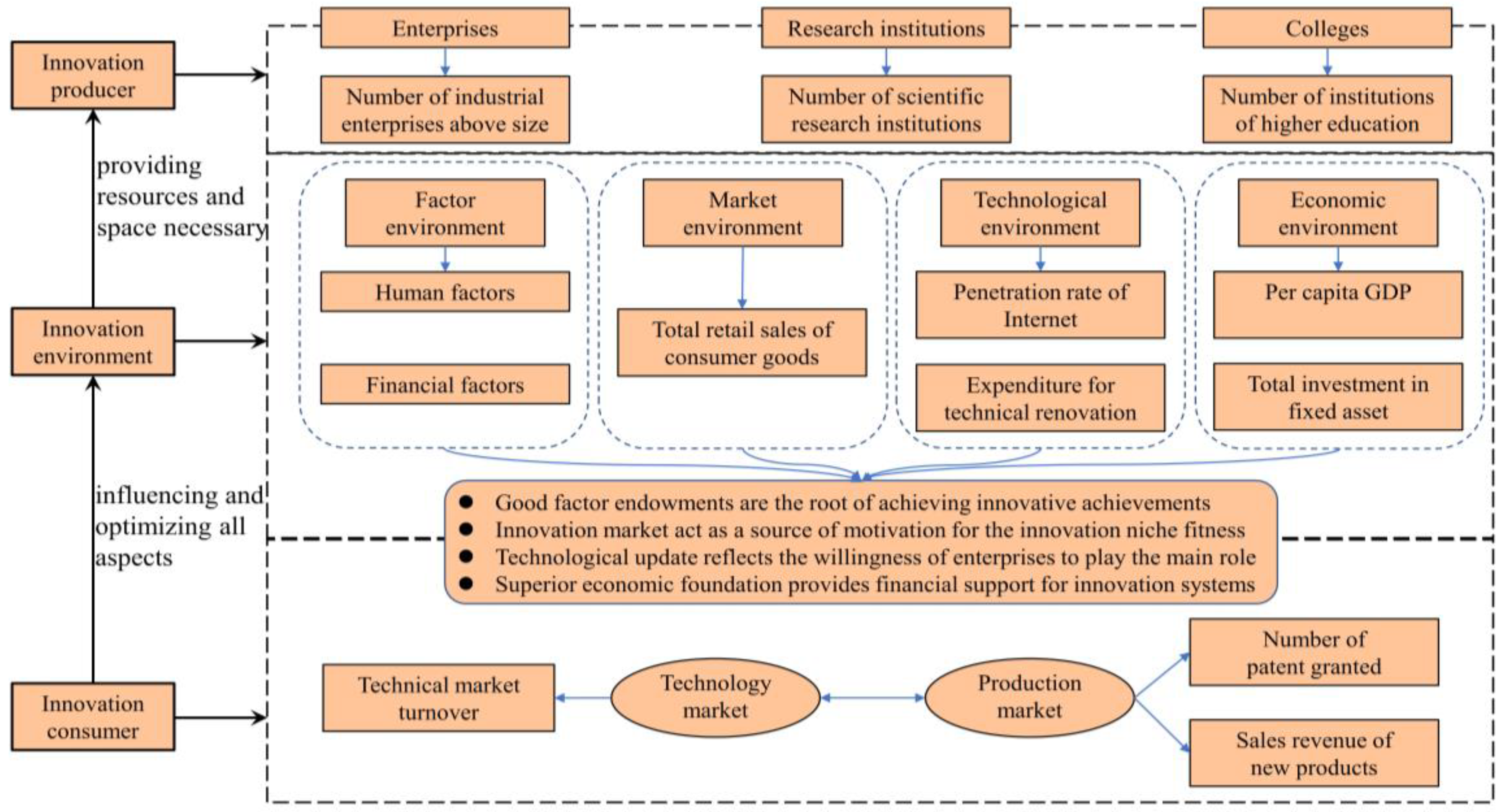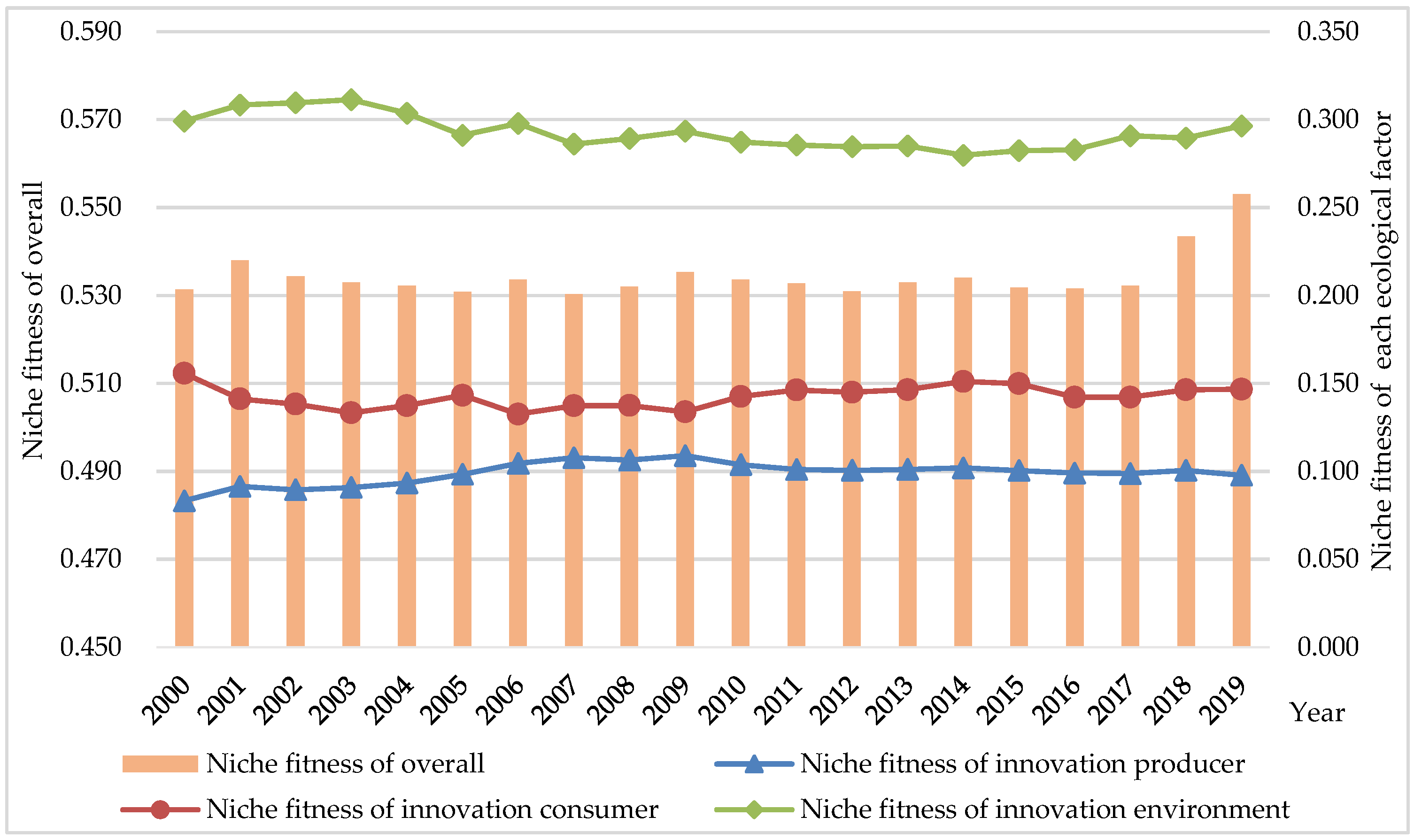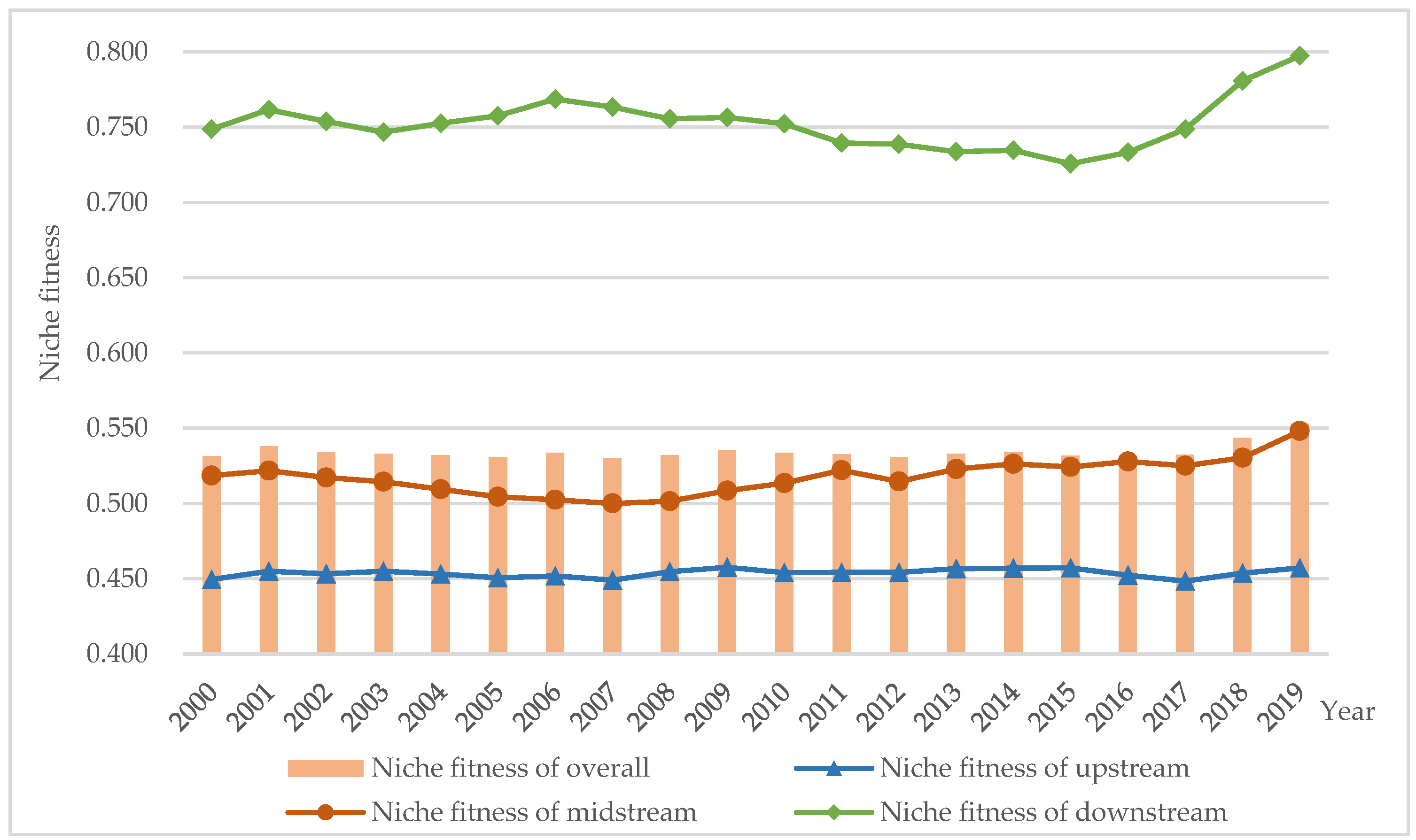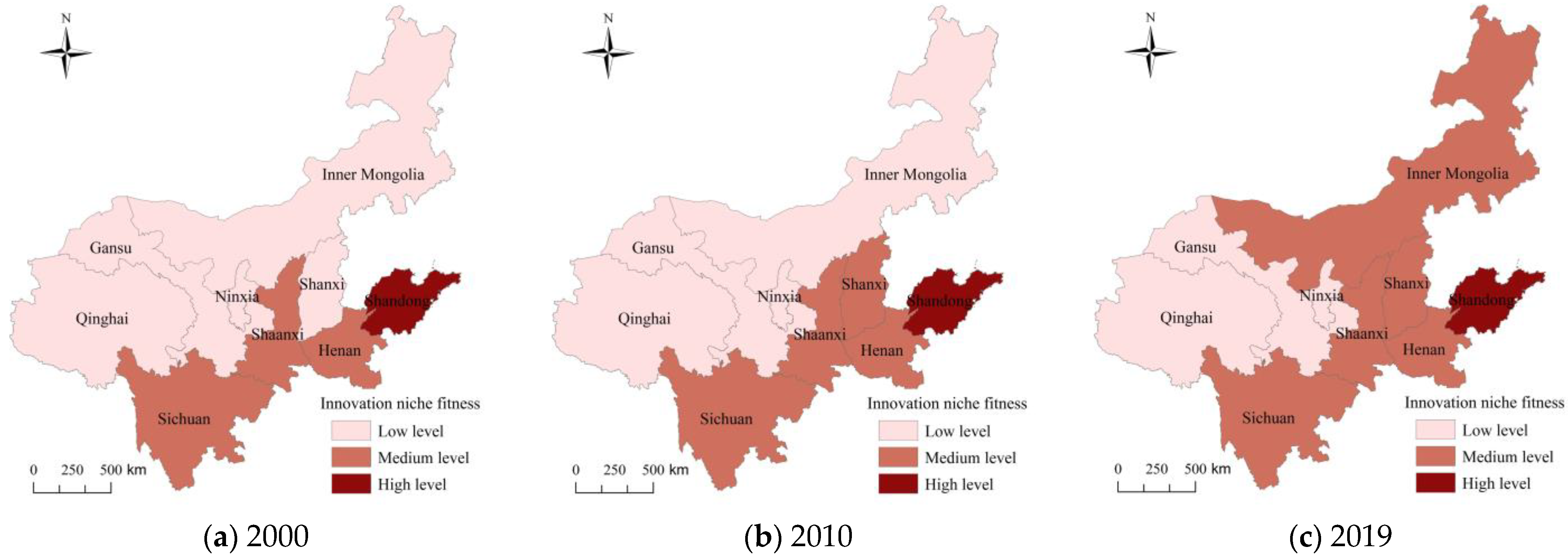Spatiotemporal Evolution and Cause Analysis of Innovation Ecosystem Niche Fitness: A Case Study of the Yellow River Basin
Abstract
1. Introduction
2. Theoretical Foundation and Research Model
2.1. Regional Innovation Ecosystem
2.2. Regional Innovation Ecosystem Niche Fitness
2.3. Analysis of Shaping Mechanisms on Regional Innovation Ecosystem Niche Fitness: Qualitative Comparative Analysis (QCA) Methods
3. Trend for Niche Fitness of Innovation Ecosystem in the Yellow River Basin
3.1. Trend for Innovation Ecosystem Niche Fitness and Each Ecological Factor in the Yellow River Basin
3.2. Trend for Innovation Ecosystem Niche Fitness in Upstream, Midstream, and Downstream Regions
3.3. Trend for Innovation Ecosystem Niche Fitness in Nine Provinces
4. Identification of Critical Influencing Variables of Niche Fitness for the Innovation Ecosystem in the Yellow River Basin
5. An Analysis of the Mechanisms That Shape Niche Fitness for the Innovation Ecosystem in the Yellow River Basin
5.1. Variable Calibration
5.2. Analysis of the Need for Individual Conditions
5.3. Sufficiency Analysis of Conditional Configurations
5.3.1. Path Analysis of High Innovation Niche Fitness
5.3.2. Path Analysis of Low Innovation Niche Fitness
6. Conclusions and Suggestions
Author Contributions
Funding
Institutional Review Board Statement
Informed Consent Statement
Data Availability Statement
Conflicts of Interest
References
- Ma, D.; Zhu, Q. Innovation in emerging economies: Research on the digital economy driving high-quality green development. J. Bus. Res. 2022, 145, 801–813. [Google Scholar] [CrossRef]
- Fukuda, K. Science, technology and innovation ecosystem transformation toward society 5.0. Int. J. Prod. Econ. 2020, 220, 107460. [Google Scholar] [CrossRef]
- Carayannis, E.G.; Grigoroudis, E.; Campbell, D.F.; Meissner, D.; Stamati, D. The ecosystem as helix: An exploratory theory-building study of regional co-opetitive entrepreneurial ecosystems as Quadruple/Quintuple Helix innovation models. R D Manag. 2018, 48, 148–162. [Google Scholar] [CrossRef]
- Pidorycheva, I.; Shevtsova, H.; Antonyuk, V.; Shvets, N.; Pchelynska, H. A conceptual framework for developing of regional innovation ecosystems. Eur. J. Sustain. Dev. 2020, 9, 626. [Google Scholar] [CrossRef]
- Kuzior, A.; Pidorycheva, I.; Liashenko, V.; Shevtsova, H.; Shvets, N. Assessment of national innovation ecosystems of the EU countries and Ukraine in the interests of their sustainable development. Sustainability 2022, 14, 8487. [Google Scholar] [CrossRef]
- Chen, Y.; Lei, H.; Hsu, W. A study on the sustainable development strategy of firms: Niche and social network theory. Sustainability 2019, 11, 2593. [Google Scholar] [CrossRef]
- Peng, B.; Zheng, C.; Wei, G.; Elahi, E. The cultivation mechanism of green technology innovation in manufacturing industry: From the perspective of ecological niche. J. Clean. Prod. 2020, 252, 119711. [Google Scholar] [CrossRef]
- Grinnell, J. The niche-relationships of the California thrasher. Auk 1917, 34, 427–433. [Google Scholar] [CrossRef]
- Hutchinson, G.E. Concluding remarks—Cold spring harbor symposia on quantitative biology. Bull. Math. Biol. 1957, 22, 415–427. [Google Scholar]
- Li, Z.Z.; Lin, H. The niche-fitness model of crop population and its application. Ecol. Model. 1997, 104, 199–203. [Google Scholar]
- Xie, X.M.; Liu, X.J.; Blanco, C. Evaluating and forecasting the niche fitness of regional innovation ecosystems: A comparative evaluation of different optimized grey models. Technol. Forecast. Soc. 2023, 191, 122473. [Google Scholar] [CrossRef]
- Yin, S.; Li, B.Z. Academic research institutes-construction enterprises linkages for the development of urban green building: Selecting management of green building technologies innovation partner. Sustain. Cities Soc. 2019, 48, 101555. [Google Scholar] [CrossRef]
- Liu, H.D.; Lu, C.X. The impact of innovation ecosystem resilience on high-quality economic development. Forum Sci. Tech. China 2023, 321, 48–57. [Google Scholar]
- Qin, L.L.; Wang, D.P.; Zhou, C. Application of integrated ecological niche suitability in the sustainability evaluation of regional innovation systems. Syst. Eng. Theory Pract. 2011, 31, 927–935. [Google Scholar]
- Ding, L.; Wu, J. Innovation ecosystem of CNG vehicles: A case study of its cultivation and characteristics in Sichuan, China. Sustainability 2018, 10, 39. [Google Scholar] [CrossRef]
- Villani, E.; Lechner, C. How to acquire legitimacy and become a player in a regional innovation ecosystem? The case of a young university. J. Technol. Transfer 2021, 46, 1017–1045. [Google Scholar] [CrossRef]
- Xie, X.M.; Liu, X.J. Evaluation and prediction of regional innovation ecosystem ecological niche suitability—An empirical study based on data from 30 Chinese provinces and cities from 2009–2018. Stud. Sci.-Sci. 2021, 39, 1706–1719. [Google Scholar]
- Zhou, C.; Zhang, X.H.; Zhang, Q. Study on the construction and spatial differences of the “Five in One” comprehensive evaluation system for the Yellow River Basin. J. Des. Res. 2021, 41, 1–11. [Google Scholar]
- Yan, X.; Bai, J.; Zhang, Y.; Hu, S. Can the ecological environment reverse feed renewable energy technology innovation?—Heterogeneity test from the Yangtze River Economic Belt. Renew. Energy 2022, 195, 1381–1392. [Google Scholar] [CrossRef]
- Geng, W.; Li, Y.; Zhang, P.; Yang, D.; Jing, W.; Rong, T. Analyzing spatio-temporal changes and trade-offs/synergies among ecosystem services in the Yellow River Basin, China. Ecol. Indic. 2022, 138, 108825. [Google Scholar] [CrossRef]
- Liu, K.; Qiao, Y.; Shi, T.; Zhou, Q. Study on coupling coordination and spatiotemporal heterogeneity between economic development and ecological environment of cities along the Yellow River Basin. Environ. Sci. Pollut. Res. 2021, 28, 6898–6912. [Google Scholar] [CrossRef] [PubMed]
- Nowak, M.A.; Tarnita, C.E.; Antal, T. Evolutionary dynamics in structured populations. Philos. Trans. R. Soc. 2010, 365, 19–30. [Google Scholar] [CrossRef] [PubMed]
- Guan, X.; Chen, L.; Xia, Q.; Qin, Z. Innovation efficiency of Chinese pharmaceutical manufacturing industry from the perspective of innovation ecosystem. Sustainability 2022, 14, 12993. [Google Scholar] [CrossRef]
- Block, J.H.; Thurik, R.; Zhou, H. What turns knowledge into innovative products? The role of entrepreneurship and knowledge spillovers. J. Evol. Econ. 2013, 23, 693–718. [Google Scholar] [CrossRef]
- Zhang, W.; Liu, P.F.; Zhang, J.K. Multi-group symbiotic evolution mechanism in an innovative ecosystem: Evidence from China. Rev. Cercet. Interv. Soc. 2019, 66, 249. [Google Scholar] [CrossRef]
- Liao, K.C.; Zhang, Y.C.; Du, Q.H. Research on the decomposition and formation mechanism of regional differences in the dynamic operating efficiency of China’s regional innovation ecosystem. Sci. Sci. Manag. Sci.-Tech. 2022, 43, 94–116. [Google Scholar]
- Gobble, M.A.M. Charting the innovation ecosystem. Res. Technol. Manag. 2014, 57, 55–59. [Google Scholar]
- Xu, K.; Bossink, B.; Chen, Q. Efficiency evaluation of regional sustainable innovation in China: A slack-based measure (SBM) model with undesirable outputs. Sustainability 2019, 12, 31. [Google Scholar] [CrossRef]
- Coles, A.M.; Piterou, A.; Sentić, A. Is small really beautiful? A review of the concept of niches in innovation. Technol. Anal. Strateg. 2018, 30, 895–908. [Google Scholar] [CrossRef]
- Chen, P.C.; Hung, S.W. An actor-network perspective on evaluating the R&D linking efficiency of innovation ecosystems. Technol. Forecast. Soc. 2016, 112, 303–312. [Google Scholar]
- Wang, L.Y.; Hu, H.Q.; Wang, X.Z. The dynamic evolution of the structure of an urban housing investment niche network and its underlying mechanisms: A case study of 35 large and medium-sized cities in China. Sustainability 2022, 14, 3523. [Google Scholar] [CrossRef]
- Schneider, C.Q.; Wagemann, C. Reducing complexity in Qualitative Comparative Analysis (QCA): Remote and proximate factors and the consolidation of democracy. Eur. J. Polit. Res. 2006, 45, 751–786. [Google Scholar] [CrossRef]
- Xia, M.; Xie, Z.M.; Lin, H.; He, X.W. Synergistic mechanism of the high-quality development of the urban digital economy from blockchain adoption perspective—A configuration approach. J. Theor. Appl. El. Comm. 2022, 17, 704–721. [Google Scholar] [CrossRef]
- Roig-Tierno, N.; Gonzalez-Cruz, T.F.; Llopis-Martinez, J. An overview of qualitative comparative analysis: A bibliometric analysis. J. Innov. Knowl. 2017, 2, 15–23. [Google Scholar] [CrossRef]
- Huang, Y.J.; Bu, Y.J.; Long, Z.H. Institutional environment and college students’ entrepreneurial willingness: A comparative study of Chinese provinces based on fsQCA. J. Innov. Knowl. 2023, 8, 100307. [Google Scholar] [CrossRef]
- Bhunia, A. Statistical Methods for Practice and Research (A Guide to Data Analysis Using SPSS). S. Asian J. Manag. 2013, 1, 154. [Google Scholar]
- Yin, D.; Ming, X.G.; Zhang, X.Y. Sustainable and smart product innovation ecosystem: An integrative status review and future perspectives. J. Clean. Prod. 2020, 274, 123005. [Google Scholar] [CrossRef]
- Du, Y.Z.; Jia, L.D. Histrionic perspective and qualitative comparative analysis (QCA): A new path for management research. J. Manag. World 2017, 33, 155–167. [Google Scholar]
- Ragin, C.C. The Comparative Method: Moving beyond Qualitative and Quantitative Strategies; University of California Press: Oakland, CA, USA, 2014. [Google Scholar]
- Fan, D.; Li, Y.; Chen, L. Configuring innovative societies: The crossvergent role of cultural and institutional varieties. Technovation 2017, 66, 43–67. [Google Scholar] [CrossRef]
- Zhang, M.; Du, Y.Z. The application of QCA methods in organization and management research: Orientation, strategy and direction. J. Manag. 2019, 16, 1312–1323. [Google Scholar]
- Pattyn, V.; Molenveld, A.; Befani, B. Qualitative comparative analysis as an evaluation tool: Lessons from an application in development cooperation. Am. J. Eval. 2019, 40, 55–74. [Google Scholar] [CrossRef]
- Wu, Y.; Yang, S.; Liu, F.; Cao, Y.; Jiang, M. The security and driving factors of the innovative ecosystem: Evidence from the Yellow River Basin. Int. J. Environ. Res. Public Health 2023, 20, 2482. [Google Scholar] [CrossRef] [PubMed]
- Cui, Z.P.; Liu, X.Y.; Qin, H.; Ji, H.M. Differential game analysis of enterprises investing in new infrastructure and maintaining social network security under the digital innovation ecosystem. IEEE Access 2022, 10, 69577–69590. [Google Scholar] [CrossRef]




| Evaluation Objectives | Primary Index | Secondary Index | Description of Secondary Indicators (Unit) |
|---|---|---|---|
| Innovation ecosystem | Innovation producer | enterprises | Number of industrial enterprises above designated size (unit) |
| research institutions | Number of regular institutions of higher education (unit) | ||
| universities | Number of scientific research institutions (unit) | ||
| Innovation consumer | technology market | Technical market turnover (104 yuan) | |
| production market | Number of patents granted (piece) | ||
| Sales revenue of new products (104 yuan) | |||
| Innovation environment | factor environment | Full-time equivalent of R&D personnel (man-year) | |
| Total expenditure on R&D (104 yuan) | |||
| Expenditure for education (104 yuan) | |||
| Number of college students per 100,000 people (students) | |||
| market environment | Total retail sales of consumer goods (104 yuan) | ||
| technological environment | Penetration rate of the Internet (%) | ||
| Expenditure for technical renovation (104 yuan) | |||
| economic environment | Per capita GDP (yuan) | ||
| Total investment in fixed assets (104 yuan) |
| Conditional Variables | Innovation Niche Fitness | |
|---|---|---|
| Relevance | Significance | |
| Number of regular institutions of higher education | 0.911 ** | 0.000 |
| Full-time equivalent of R&D personnel | 0.892 ** | 0.000 |
| Number of regular institutions of higher education | 0.853 ** | 0.000 |
| Number of scientific research institutions | 0.847 ** | 0.000 |
| Expenditure for technical renovation | 0.782 ** | 0.000 |
| Sales revenue of new products | 0.743 ** | 0.000 |
| Total expenditure on R&D | 0.728 ** | 0.000 |
| Total retail sales of consumer goods | 0.715 ** | 0.000 |
| Number of patents granted | 0.796 | 0.010 |
| Technical market turnover | 0.784 | 0.012 |
| Number of college students per 100,000 people | 0.277 | 0.471 |
| Per capita GDP | 0.142 | 0.058 |
| Expenditure for education | 0.547 | 0.119 |
| Total investment in fixed assets | 0.273 | 0.478 |
| Penetration rate of the Internet | 0.016 | 0.829 |
| Variables | Complete Affiliation | Crossover Point | Complete Unaffiliation |
|---|---|---|---|
| Innovation niche fitness | 0.791 | 0.489 | 0.413 |
| Number of industrial enterprises above designated size | 25,774.980 | 3930.850 | 630.900 |
| Number of scientific research institutions | 201.130 | 113.800 | 22.370 |
| Number of regular institutions of higher education | 111.700 | 64.900 | 12.120 |
| Sales revenue of new products | 63,278,259.266 | 7,568,820.630 | 802,816.281 |
| Full-time equivalent of R&D personnel | 151,169.599 | 37,214.730 | 4864.307 |
| Total expenditure on R&D | 5,734,580.940 | 876,388.000 | 118,688.900 |
| Total retail sales of consumer goods | 13,042.694 | 3470.448 | 441.967 |
| Expenditure for technical renovation | 2,134,257.022 | 550,546.290 | 119,845.275 |
| Variables | High Innovation Niche Fitness | Low Innovation Niche Fitness | ||
|---|---|---|---|---|
| Consistency | Coverage | Consistency | Coverage | |
| Number of industrial enterprises above designated size | 0.817 | 0.873 | 0.436 | 0.609 |
| ~Number of industrial enterprises above designated size | 0.589 | 0.416 | 0.809 | 0.841 |
| Number of scientific research institutions | 0.845 | 0.779 | 0.504 | 0.609 |
| ~Number of scientific research institutions | 0.526 | 0.420 | 0.817 | 0.856 |
| Number of regular institutions of higher education | 0.830 | 0.771 | 0.462 | 0.562 |
| ~Number of regular institutions of higher education | 0.472 | 0.374 | 0.812 | 0.845 |
| Sales revenue of new products | 0.805 | 0.836 | 0.421 | 0.641 |
| ~Sales revenue of new products | 0.655 | 0.435 | 0.892 | 0.870 |
| Full-time equivalent of R&D personnel | 0.896 | 0.863 | 0.409 | 0.578 |
| ~Full-time equivalent of R&D personnel | 0.562 | 0.393 | 0.803 | 0.827 |
| Total expenditure on R&D | 0.802 | 0.800 | 0.419 | 0.613 |
| ~Total expenditure on R&D | 0.612 | 0.418 | 0.863 | 0.865 |
| Total retail sales of consumer goods | 0.817 | 0.785 | 0.442 | 0.623 |
| ~Total retail sales of consumer goods | 0.607 | 0.426 | 0.848 | 0.872 |
| Expenditure for technical renovation | 0.882 | 0.784 | 0.469 | 0.611 |
| ~Expenditure for technical renovation | 0.563 | 0.419 | 0.835 | 0.812 |
| Conditional Variables | High Innovation Niche Fitness | Low Innovation Niche Fitness | ||||
|---|---|---|---|---|---|---|
| H1a | H1b | H2 | H3 | NH1a | NH2 | |
| Number of industrial enterprises above designated size |  |  |  |  | ||
| Number of scientific research institutions |  |  |  | |||
| Number of regular institutions of higher education |  |  |  |  |  | |
| Sales revenue of new products |  |  |  |  |  | |
| Full-time equivalent of R&D personnel |  |  |  |  |  |  |
| Total expenditure on R&D |  |  |  |  |  | |
| Total retail sales of consumer goods |  |  |  |  | ||
| Expenditure for technical renovation |  |  | ||||
| Consistency | 0.92 | 0.93 | 0.92 | 0.87 | 0.97 | 1 |
| Coverage | 0.41 | 0.45 | 0.74 | 0.48 | 0.75 | 0.22 |
| Unique coverage | 0.02 | 0.01 | 0.01 | 0.01 | 0.48 | 0.12 |
| Consistency of solutions | 0.85 | 0.97 | ||||
| Coverage of solutions | 0.91 | 0.81 | ||||
 indicates that the core condition is present;
indicates that the core condition is present;  indicates that the marginal condition is present;
indicates that the marginal condition is present;  indicates that the core condition is missing;
indicates that the core condition is missing;  indicates that the marginal condition is missing; a space indicates that the condition is optional.
indicates that the marginal condition is missing; a space indicates that the condition is optional.Disclaimer/Publisher’s Note: The statements, opinions and data contained in all publications are solely those of the individual author(s) and contributor(s) and not of MDPI and/or the editor(s). MDPI and/or the editor(s) disclaim responsibility for any injury to people or property resulting from any ideas, methods, instructions or products referred to in the content. |
© 2023 by the authors. Licensee MDPI, Basel, Switzerland. This article is an open access article distributed under the terms and conditions of the Creative Commons Attribution (CC BY) license (https://creativecommons.org/licenses/by/4.0/).
Share and Cite
Zhang, X.; Hu, H.; Zhou, C. Spatiotemporal Evolution and Cause Analysis of Innovation Ecosystem Niche Fitness: A Case Study of the Yellow River Basin. Sustainability 2023, 15, 9454. https://doi.org/10.3390/su15129454
Zhang X, Hu H, Zhou C. Spatiotemporal Evolution and Cause Analysis of Innovation Ecosystem Niche Fitness: A Case Study of the Yellow River Basin. Sustainability. 2023; 15(12):9454. https://doi.org/10.3390/su15129454
Chicago/Turabian StyleZhang, Xuhong, Haiqing Hu, and Cheng Zhou. 2023. "Spatiotemporal Evolution and Cause Analysis of Innovation Ecosystem Niche Fitness: A Case Study of the Yellow River Basin" Sustainability 15, no. 12: 9454. https://doi.org/10.3390/su15129454
APA StyleZhang, X., Hu, H., & Zhou, C. (2023). Spatiotemporal Evolution and Cause Analysis of Innovation Ecosystem Niche Fitness: A Case Study of the Yellow River Basin. Sustainability, 15(12), 9454. https://doi.org/10.3390/su15129454





